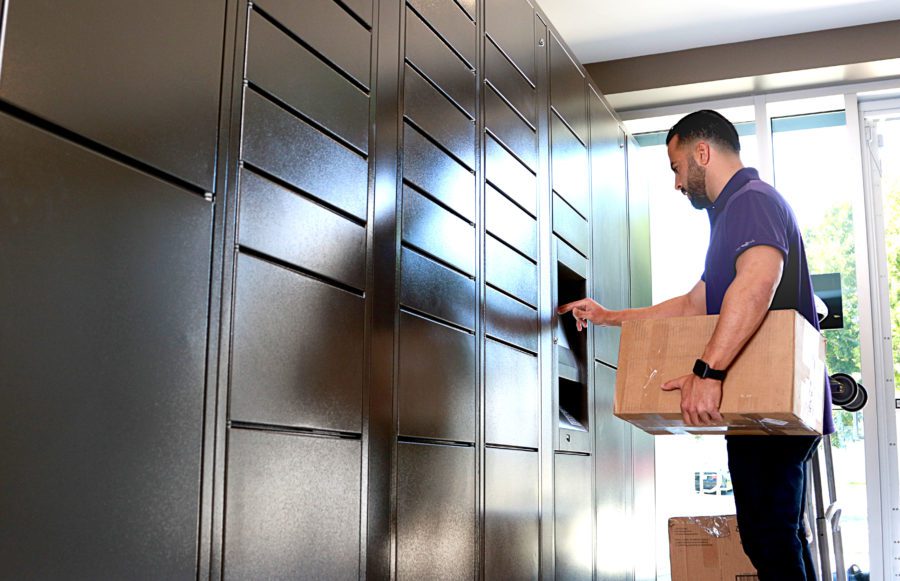
Our Blog
Improving the Remote & Campus Experience at Your University
Written by: Parcel Pending
5 Min Read
Published: October 20, 2023
Updated: November 9, 2023
As we enter post-pandemic normalcy, many universities leveraged the unconventional learning period from 2020 to 2022 to determine how to transform their college campuses and create a better campus life experience for their students.
Why the Campus Experience Matters
Students today are engulfed in social media while also feeling isolated; they are aware of mental health issues, but demand resources (e.g., health services, counseling services); and they want a college education while also looking for student/life balance. In short, the college experience today is different today than it was pre-COVID. Sophisticated colleges and universities are cultivating a better campus experience and student affairs. After all, a solid student campus life experience and leads to increased student engagement, higher success rates, improved student organization participation, and greater academic achievement.
Remote Learners Deserve a Better College Experience Too
Remote learning has exploded into the mainstream. New approaches are being examined and implemented beyond Zoom lectures to offer learning opportunities to working employees, financially struggling students, and geographically and physically challenged students.
However, remote learning is not without its own challenges. A key issue that remains for off-campus learning students is engagement. Tracking talk time, participation, and resource sharing can all be measured to evaluate and quantify student performance. Discussion groups, check-in polls, and quizzes also work as benchmarks to encourage participation. One study from the Asian Journal of University Education found that virtual learning may not provide the interactions necessary for peer review and group work1.
Thanks to TikTok with its 1.7 billion active users and 52 minutes spent on it daily, students and educators have embraced short-form video learning.2 Studies demonstrate that videos shorter than two minutes have the best engagement and 95% of video watchers retain what they learn compared to 10% who retain what they read.3
The Role of Technology in the Campus Experience
The most technologically advanced schools are creating a student-centered approach to learning that allows for self-pacing, creativity, and problem-solving skills that aid in employment opportunities. As Harvard University states: “Institutions must begin leveraging digital technologies to track how different students engage with course materials presented to them in text, audio, video, simulations, AR/VR enhancements, and so on in near real-time”.4
Create a Continuous Feedback Loop
To improve the students’ experience on campus, they must be heard. Understand their pain points, feel their failure zones, and tune in to their suggestions on how to fix the issue. Most importantly, faculty and support staff must also give their opinions. These three strategies work towards gaining input:
- Give Advance Notice – A regular schedule of soliciting feedback alerts all respondents to the importance of this activity. It also affords them the opportunity to prepare and save experiences for the survey.
- Act on Learnings – Routinely gathering information without activating the learnings makes it seem as if suggestions are falling on deaf issues. Regularly report to all students, faculty, and support staff what action steps have been taken.
- Create a Safe Feedback Environment – Give your students and faculty a safe, anonymous, and convenient way to provide feedback. Of course, utilize a digital survey platform to reinforce the role of technology.
Adopt a Holistic Approach to Student Retention and Success
American University, for example, discovered that the four centers of college life – academic, social, financial, and health – were disparate versus integrated.5 In fact, after receiving the student’s initial deposit but before arriving on campus, students received a total of 130 messages from many different offices!
A new model endorsed by Achieving the Dream and Promoting At-Promise Student Success fosters the concept of a holistic approach to student success and well-being/wellness. Quinnipiac University in Connecticut also noted the student frustration with administrative, academic, financial aid, and student housing in separate departments. Today, these student services are all housed in the same office. A recent Rand Corporation study of four community college systems found a 3% average increase in student retention by moving to an integrated model, with better outcomes for adult learners over the age of 25 and students of color.6
Expand the Definition of Diversity and Inclusion
There is inclusivity beyond gender, race, and orientation. Think about expanding your reach to get more participation in specific sports/wellness/fitness classes, student clubs/student organizations, student affairs groups, or classes that are typically associated with one group more than another.
Implement a Campus Hub™
Similar to the need for integrating student services under one roof, there’s a growing need to improve campus safety while also creating a central exchange point for needed goods. Instead of sending students to the administration building, mailroom, bookstore, and admissions office, for example, savvy leadership at higher education institutions are leveraging smart lockers.
Smart lockers, originally invented to manage parcel delivery, have now transformed into a central distribution system that comes complete with tracking software. This self-service option works to improve campus safety, as well as significantly lower labor costs and elevating and modernizing the student experience: universities can do more with fewer staff while, at the same time, students can securely retrieve goods and documents on their schedule.
Often overlooked is that this Campus Hub™ also acts as a returns system. Whether it’s returning a library book, classroom material, or purchased goods, the barcode or PIN-driven system allows for an easy and safe remittance of goods.
As universities evaluate how to retain students, improve the campus experience, and create a better quality of life, it’s time to turn to smart lockers.
Ready to discover how smart lockers can elevate the campus experience for students at your university? Speak to one of our package management experts today.
Sources:
- Basar, Z., Mansor, A., Jamaludin, K., & Alias, B., “The Effectiveness and Challenges of Online Learning for Secondary School Students”, Asian Journal of University Education v. 17, n. 3, p. 119-129 (2021). https://doi.org/10.24191/ajue.v17i3.14514.
- Ceci, L. Number of TikTok users worldwide from 2018 to 2027. www.statista.com. August 23, 2023. https://www.statista.com/forecasts/1142687/tiktok-users-worldwide
- Kwall. Videography is More Important Than Ever in Higher-Ed Recruiting. www.kwallcompany.com. February 17, 2022. https://www.kwallcompany.com/2022/02/17/videography-is-more-important-than-ever-in-higher-ed-recruiting/
- Mapsted. 5 Ways Technology Increases Student Engagement in Higher Education in 2023. www.mapsted.com. April 6, 2023. https://mapsted.com/blog/ways-to-increase-student-engagement
- Bass, Scott. Try these strategies to improve the student experience on campus. www.highereddive.com. April 24, 2023. https://www.highereddive.com/news/strategies-improve-student-experience/643401/
- Daugherty, Lindsay, William R. Johnston, and Tiffany Berglund, “Connecting College Students to Alternative Sources of Support: The Single Stop Community College Initiative and Postsecondary Outcomes”. Santa Monica, CA: RAND Corporation, 2020. https://www.rand.org/pubs/research_reports/RR1740-1.html



